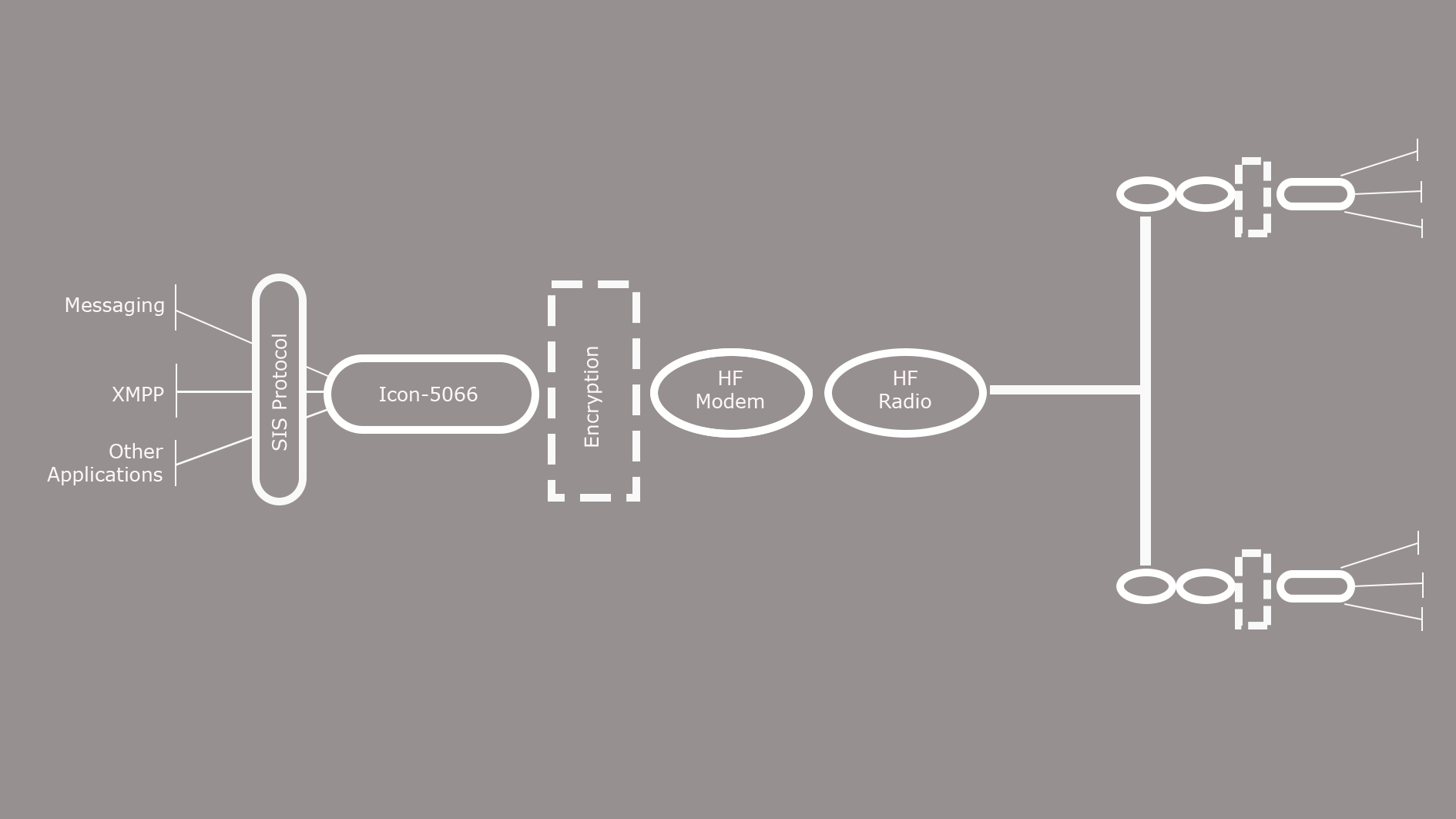
Icon-5066 is a modem-independent STANAG 5066 server. It enables applications to work efficiently over HF Modems/Radios and allows multiple applications to work simultaneously.
Icon-5066 will connect to one or two HF modems, either through a Crypto box or directly, and provides a single interface to an HF network, which can be shared by multiple applications.
The diagram below shows how Icon-5066 is deployed in conjunction with an HF network and two peers, which may use Icon-5066 or another product compliant to STANAG 5066.
This diagram shows single modem; notes on use of two modems is given under duplex and split site below. This diagram and page looks at deployments with Icon-5066 “red side” only (above modem). Operation with black side elements is described in the Crypto Bypass tab.
Applications connect to Icon-5066 using the STANAG 5066 SIS (Subnet Interface Service) protocol. Each application uses one of 16 SAP IDs (Service Access Point Identifier).
Architecture
Icon-5066 runs as several processes on Windows or Linux, as shown in the diagram below:
- Icon-5066 Distributed Data Service (DDSD) provides orchestration of the Icon-5066 service and monitoring management capabilities. DDSD runs as a Windows or Linux service. Management is via Web Browser connecting to this service using OAuth authentication. DDSD manages and controls all of the nodes on the core service.
- The Icon-5066 Core service comprises one or more independent Icon-5066 nodes controlled by DDSD. Each of these nodes implements the STANAG 5066 protocols and connects to a modem. This enables multiple STANAG 5066 services to be conveniently run on a single server.
Each Icon-5066 node can have one or more drivers configured that support a variety of capabilities. These drivers are implemented in the Lua scripting language. This has a number of advantages:
- It enables Isode to offer a selection of drivers to address different configuration requirements.
- It allows Isode customers and partners to easily develop custom drivers to meet specific needs.
The main drivers in Icon-5066 are:
- Modem Driver. This is the most likely driver that Isode customers will provide, in order to support additional modem types.
- Rate Change Driver. This controls selection of transmission parameters when changing speed.
- Transmission Control. This controls choice of a number of modes of operation:
- Half-Duplex
- Full-duplex
- Broadcast
- CSMA (Carrier Sense Multiple Access)
- WTRP (Wireless Token Ring Protocol)
- ALE 1:1 (Use of Automatic Link Establishment to control access to a single peer at a time)
- ALE Configuration: two drivers support ALE configuration
Key Features
Full Duplex & Broadcast
The most common form of HF communication is Half-duplex, where transmission direction alternates. This is often used for reliable (ARQ) transmission between a pair of nodes where each node alternately transmits and receives. Icon-5066 supports two additional modes of STANAG 5066 compliant communication:
- Broadcast. Where a node continuously sends non-ARQ traffic and never receives any data. This will typically be used at fixed frequency from a transmit-only site.
- Full-duplex. Simultaneous transmission and reception on two separate frequencies. Full-duplex gives significant performance benefits, but can only be used in configurations where sufficient separation can be achieved between transmit and receive sites. Icon 5066 provides two modes of full-duplex operation; Single modem (where the modem is operating in full-duplex) and Two modems, independently configured, where one is used for Transmit and the other for Receive.
Split Site
Icon-5066 can drive two modems in half duplex mode. This is important for split site operation where Tx Modems and Radios are located at different sites to Rx Modems and Radios.

